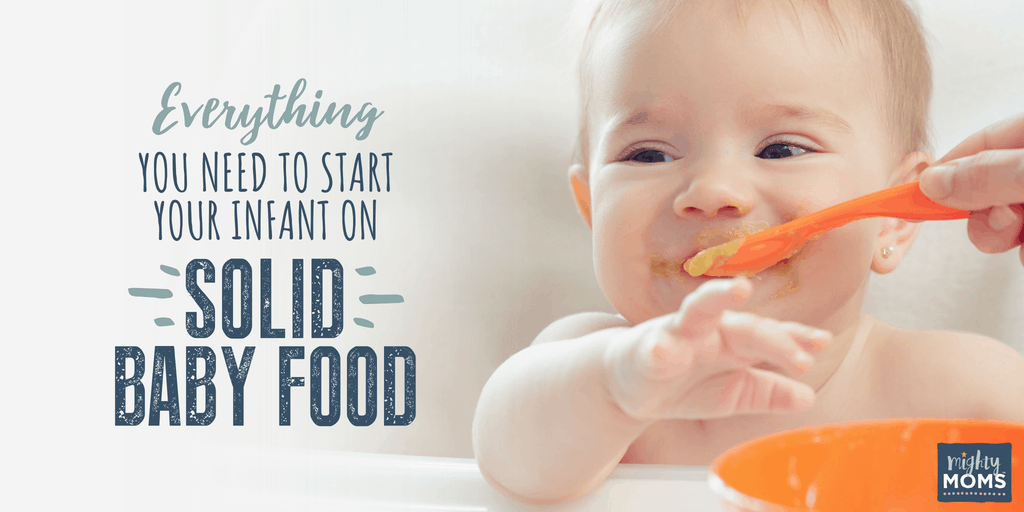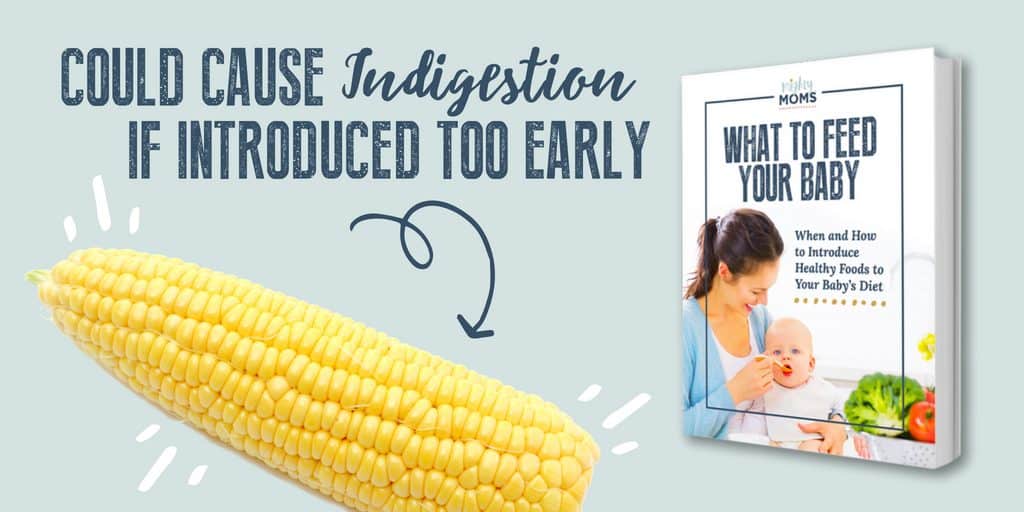
All the signs are there. Your fast-growing infant is finally ready to start eating solid baby food. So….how is that supposed to happen?
The thing is, his tiny tummy is tricky. There are some things that teeny tiny gut is ready for: pureed sweet potatoes. There are somethings his tummy is NOT ready for: steak, Mt. Dew, and Dad’s ghost-pepper BBQ sauce.
What You Need to Know About Introducing Baby Food
Like everything in your baby’s life, there’s a rhythm to whatfoods should be introduced when. Otherwise your baby will end up taking the express train to Vomitville. Here’s a simple schedule of introducing baby foods.
I want to start, though, with my Number Uno Rule when it comes to introducing solid baby food.
Introducing Baby Food Rule #1:
Make it Choke-Proof
I have a terrible, gut-wrenching, bile-wretching fear of watching one of my kids choke.
Actually, let me revise that.
I have a terrible, gut-wrenching, bile-wretching fear of watching anyone’s kids choke. (That includes yours.)
So my first rule is to transform that food into something that they absolutely cannot choke on. This means…
- Overcooking, pureeing, and straining foods for beginning eaters so there are no lumps whatsoever.
- Adding breastmilk or formula to thin cereals and purees out and get the right consistency.
- Dicing pieces of overripe fruit and rolling them in oat bran (prevents slipping down the wrong tube) for older babies & toddlers.
Remember, babies gum food, they don’t chew it. Keep foods mushy until his molars arrive in his second year.
If you don’t want to mess with steamer baskets (and who does, really) check out God’s gift to homemade baby foodies.
Introducing Baby Food at 6 Months
For babies just starting their eating adventures, think “tasting liquids” not “eating solids”. His food should be literally dripping off the spoon.
As he starts this lesson in The Art of Feeding My Face, don’t be surprised when he shoves most of the food out with his tongue. That’s actually not a “I hate this food” message.
It actually takes a completely different set of tongue movements to eat off a spoon than to suck out a bottle or breast. In his mind, he’s trying to breastfeed this new-fangled “drink” off of some silly cup-on-a-stick.
I didn’t start introducing baby food to my youngest Bella until almost 8 months. She had NO interest in eating solids, and since she was still gaining weight, the doctor gave me the a-okay in waiting (she was off the growth charts already). Just because he’s six months doesn’t mean he’s ready to eat solid foods. You are the expert on your baby remember? Talk with your doctor and then decide what’s best for your family.
Starting the Solid Baby Food Adventure
Blend up these fruits and cooked vegetables with formula or breastmilk, strain to remove any lumps, and then freeze in ice-cube trays for homemade healthy baby food. (Takes minutes and will save you a fortune!) You can find a complete list of fruits and vegetables in the popular booklet What to Feed Your Baby.
- Ripe Avocado
- Ripe Banana
- Pears
- Sweet Potatoes
Making your own baby cereals at home is eye-rolling easy. (Not to mention better for your baby nutritionally.) Just grind the grains before cooking (with a clean coffee grinder or the 4-in-1 Baby Food Maker Pro), and then cook on the stove using 2:1 ratio. (Example: 2 cups of water for 1 cup of grain) Finally, thin it out with breastmilk or formula to make it safely soupy.
Here are the grains usually safe to introduce at this age.
- Brown Rice
- Barley
- Millet
- Oats
You’re probably going to end up with a LOT more cereal than you need. Simply divvy it up into smaller containers and refrigerate for 2-3 days. Then pop it in the microwave before stirring in some whole-milk yogurt or a pureed fruit above.
Introducing Baby Food at 7 Months
If your beginning eater has been slurping off the spoon easily, it may be time to thicken things up a little bit! Now, instead of watery-soup, you’ll want to shoot for the consistency of heavy cream. Still undoubtedly liquid, but thick enough to stick on the spoon.
This is also the age when you can start offering diluted fruit juices: apple, apricot, grape, pear, papaya, pear, peach, and prune. Only offer juice once a day. Formula, breastmilk, and water should be his primary liquids (and, actually, his primary nutrition) at this age.
Besides the foods above (and the fruits and veggies listed in What to Feed Your Baby) here are some additional foods you can work into the rotation at this age.
- Silken Tofu—blended
- Cottage Cheese—small curd
- Egg Yolks—hard cooked and mashed (not the whites yet!)
- Poultry—cooked and pureed
- Beef—cooked and pureed
- Veal—cooked and pureed
- Lamb—cooked and pureed
Introducing Baby Food at 8 Months
It’s clear now he’s got the “gumming” concept of eating down pat. It’s time to let him experiment with a few small finger foods. Give him only one or two at first, or he may attempt to chipmunk-cheek himself.
Since he’s just a beginner, make sure everything you give him can be swallowed whole. You may also want to roll diced pieces of fruit in oat bran to further protect against choking. (Slippery food is easily choked on.)
Here’s the list of items you can add on to his food list at 8 months. Find the complete fruit and veggie list in this inexpensive booklet.
- Apples—peeled
- Broccoli
- Tahini Spread
- Ground nuts—experts actually recommend introducing nuts earlier than once thought.
- Cheese—shredded or grated
- Finely ground seeds
- Lean fish like flounder, sole, cod, catfish, haddock—cooked and pureed
Introducing Baby Food at 9 Months
The 9-month mark is a great time to introduce your infant to cooked beans, lentils, and split peas. Cook them well before mashing into a paste to serve. This is an excellent way for your baby get some bone-and-brain building proteins!
These foods, when cooked, can be added to your solid baby food list:
- Pineapple
- Berries—see the complete list here
- Onions—diced and cooked
- Kale and other powered-up vegetables
- Pork and ham—cooked and pureed
- Liver and kidney—cooked and pureed
- Fatty fish like tuna, halibut, bluefish, sardines, and salmon—cooked and pureed
Introducing Baby Food at 10 Months
You can begin to introduce finely grated raw fruits and vegetables as fun new finger snacks at this age. Raw (peeled) apples, summer squash, sweet peppers, and carrots, finely shredded provide a new texture for him to try with his new teeth.
Here are a few things you can add to his diet this month.
- Sweet Bell Peppers—finely grated
- Lettuce—finely grated
- Bulgur Grain Cereal
- Cornmeal
- Whole Grain Pastas—small enough to swallow whole
- Thinned creamy peanut butter—if no family history of severe nut allergies
Introducing Baby Food at 12 Months
The first birthday is a HUGE milestone for your little guy! Besides eating his first cake and ripping open gifts, a whole new culinary world of options will open up.
This is also a great time to introduce the wonders of The Sippy Cup. Try introducing it for one meal a day, eventually replacing the bottle completely at around 18 months.
Here are the foods good for introducing baby food at 12 months. Continue to dice and overcook these foods, though! Lumpy is good. Hard chunks are not.
- Honey
- Various citrus fruits—get the complete list here
- Wheat Germ
- Cow’s milk
- Hard-cooked Egg Whites
- Shellfish—cooked and finely chopped (if no severe family allergies)
See How Easy That Was?
Introducing baby food is one of the highlights of parenting in the first year. What parent hasn’t grabbed the phone in a panic to capture the first taste of a lemon? Or the final smear of a new sweet potato hair style?
Now you can enjoy these precious moments without that knot of worry settling in your stomach. You know exactly what solid baby foods should be introduced when!
And if you can’t remember, don’t forget to pick up your beautifully designed What to Feed Your Baby for a quick counter-top reference.
Healthy babies are happy babies!
Have You Read These Yet?
- Is Your Baby Getting These Key Nutrients in His Baby Food?
- How Do You Get Your Toddler Eating Healthy Food? Like This.
- 10 Toddler Recipes Guaranteed to Delight Your Tiny Critic
- Everything a New Mama Warrior Needs to Know About Baby Care
We ♥ honesty! This post contains affiliate links that provide extra money for our mutual coffee habits addictions. Click here to learn more. As an Amazon Associate I earn from qualifying purchases.






